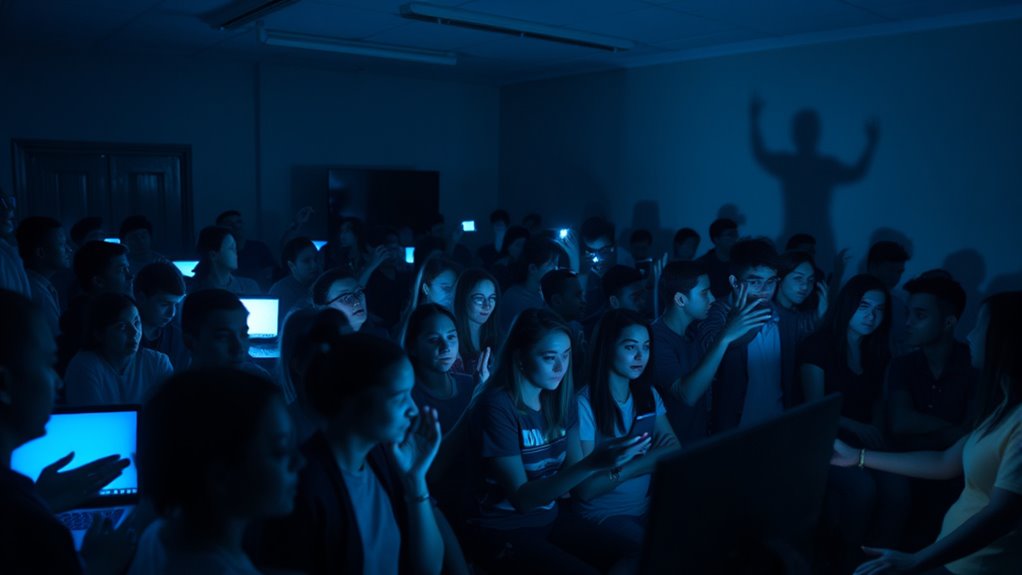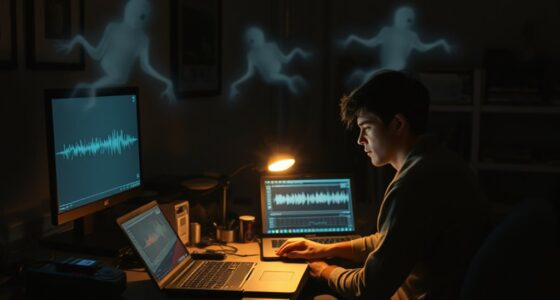Engaging the public in crowdsourcing paranormal investigations online lets you share sightings, evidence, and ideas with a global community of enthusiasts. Platforms like ghost-hunting apps, websites, and social media allow you to upload data, analyze findings, and collaborate remotely. Using these tools, you can help verify evidence, identify patterns, and contribute to collective research. If you want to discover how technology and community efforts enhance investigations, there’s more to explore below.
Key Takeaways
- Utilize online platforms and social media to invite public participation in sharing paranormal experiences and evidence globally.
- Implement standardized protocols and training to ensure data quality and consistency from diverse contributors.
- Leverage crowdsourcing projects and collaborative tools for collective data analysis, increasing investigation depth and reach.
- Employ validation techniques like technical analysis and peer review to enhance evidence credibility and reduce false reports.
- Incorporate emerging technologies such as AI, drones, and VR to expand remote investigation capabilities and public engagement.
The Rise of Online Platforms for Paranormal Enthusiasts
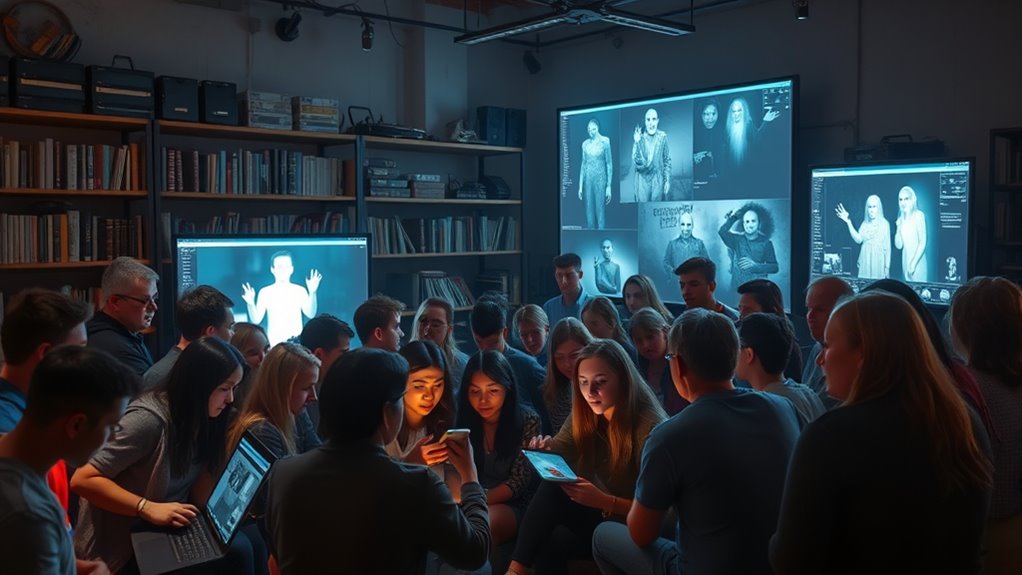
Online platforms have revolutionized how paranormal enthusiasts connect and investigate. Now, you can share your experiences, exchange evidence, and seek advice from a global community instantly. Websites, forums, and social media groups provide spaces where you can discuss sightings, ask questions, and collaborate on investigations. These platforms break geographical barriers, allowing you to join others who share your passion, regardless of your location. They also host crowdsourced projects that encourage collective data collection and analysis, making investigations more exhaustive. As a member, you gain access to a wealth of resources, expert insights, and real-time updates on ongoing phenomena. This digital shift empowers you to participate actively, learn from others, and feel less isolated in your paranormal pursuits. Cookies are often used to enhance user interaction and improve the overall experience on these platforms.
Benefits of Crowdsourcing in Investigating Unexplained Phenomena
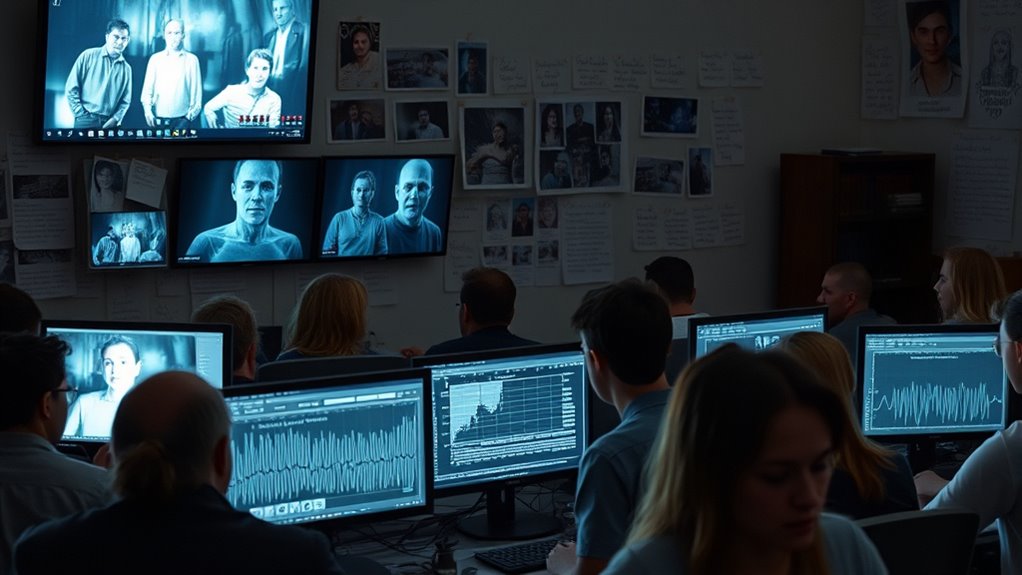
Crowdsourcing substantially enhances the investigation of unexplained phenomena by harnessing the collective efforts and diverse perspectives of a global community. When more people contribute observations, photos, and videos, you gain access to a wider array of data that might otherwise be overlooked. This collaborative approach enables faster identification of patterns or anomalies, increasing the chances of uncovering new insights. Additionally, crowdsourcing taps into varied expertise, from amateur enthusiasts to seasoned researchers, enriching analyses with different viewpoints. It also promotes transparency and community engagement, making investigations more credible and inclusive. As a result, you benefit from a more robust, dynamic process that can adapt quickly to new information, ultimately advancing our understanding of mysterious phenomena more effectively than isolated efforts. Recognizing the importance of grocery store hours can also inform how we plan our investigations and community events related to paranormal activities.
Popular Websites and Apps Facilitating Community Engagement
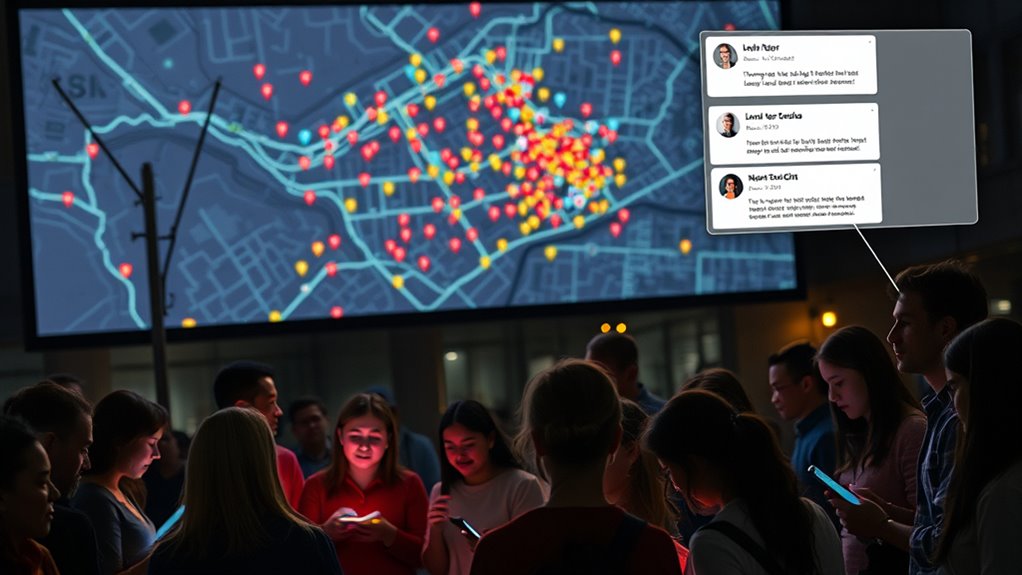
Numerous websites and apps have emerged as powerful tools for community engagement in paranormal investigations. These platforms enable enthusiasts to share experiences, upload evidence, and collaborate remotely. They foster a sense of community and collective curiosity. Some apps focus on real-time data collection, while others host forums for discussion and analysis. The following table highlights popular platforms: | Website/App | Key Feature | |————————|——————————————–| | Ghost Hunting Tools | Collaborative investigation resources | | Paranormal Database | User-submitted evidence and sightings | | SpiritBox App | Audio analysis for EVP detection | | Haunted Places Map | Geolocated reports of paranormal activity | Additionally, many of these platforms incorporate crowdsourcing to enhance the accuracy and breadth of paranormal data collected.
Methods for Collecting and Sharing Evidence Remotely
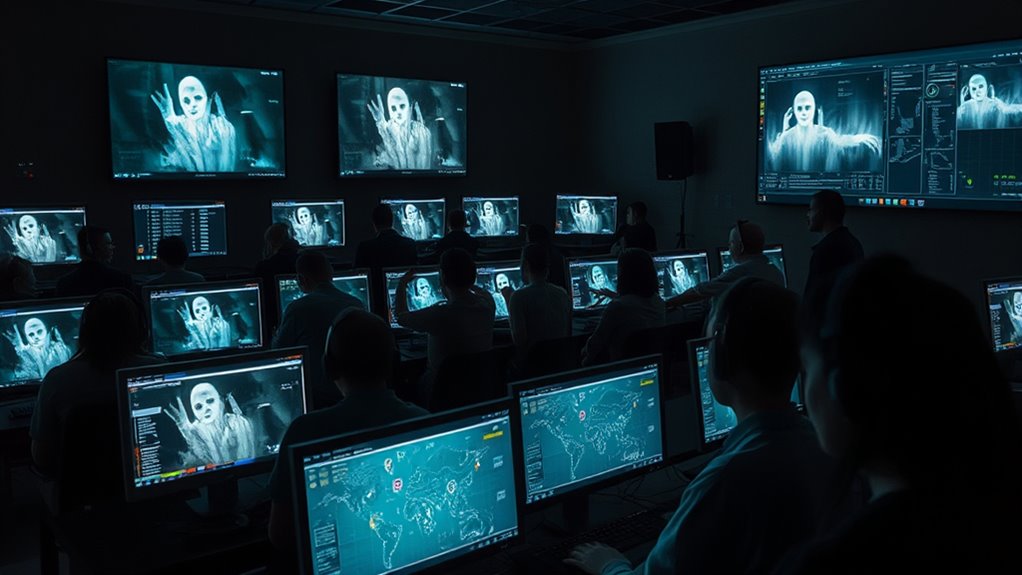
You can use digital evidence platforms to upload and organize your findings quickly. Remote collaboration tools enable team members to review and discuss evidence in real-time, no matter where they are. Together, these methods make sharing and analyzing paranormal data more efficient and accessible. Incorporating color accuracy considerations can also help ensure that visual evidence is represented faithfully and reliably.
Digital Evidence Platforms
Digital evidence platforms have revolutionized how paranormal investigators collect and share data remotely. These online tools enable you to upload photos, videos, audio recordings, and detailed reports directly to a centralized database. With real-time access, you can analyze evidence collaboratively, regardless of location. Many platforms incorporate tagging and categorization features, making it easier to organize and search through large amounts of data. Automated timestamping and GPS tagging help verify when and where evidence was captured, adding credibility. Secure sharing options allow you to distribute evidence to team members or the public while maintaining control over access. By streamlining data collection and dissemination, digital evidence platforms empower you to build a more extensive and transparent investigation, fostering community engagement and collective analysis. Additionally, incorporating proper documentation and metadata enhances the credibility and reliability of your evidence, ensuring it can be assessed accurately by others.
Remote Collaboration Tools
Remote collaboration tools have transformed how paranormal investigators gather and share evidence from afar. With these tools, you can upload, analyze, and discuss evidence in real-time, no matter where you are. Video conferencing platforms enable live discussions, while cloud storage ensures seamless sharing of audio, video, and photos. Additionally, specialized apps allow multiple users to annotate and review evidence collectively. Here’s a quick overview:
| Tool Type | Functionality |
|---|---|
| Video Conferencing | Live communication and remote interviews |
| Cloud Storage | Securely share and access large files |
| Annotation Apps | Collaborative review and note-taking |
These tools make crowdsourced investigations more efficient, engaging, and inclusive, allowing the public to participate actively in the process. Modifications to evidence sharing and collaboration are possible with changes in technology or investigation needs, enhancing collaborative review capabilities.
Case Studies: Successful Crowdsourced Paranormal Projects
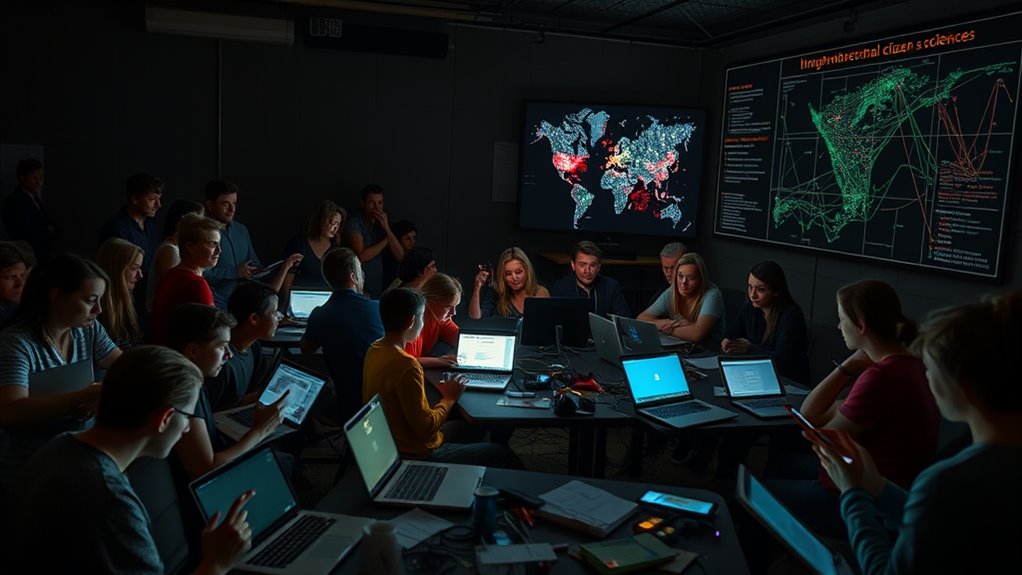
Many successful crowdsourced paranormal projects rely on digital collaboration platforms that connect investigators and enthusiasts worldwide. These campaigns often gather and analyze evidence more effectively by pooling resources and insights. Exploring notable examples reveals how community efforts can lead to significant breakthroughs in understanding paranormal activity. Additionally, implementing outdoor‑kitchen essentials can facilitate organized field investigations and community gatherings, enhancing participant engagement and data collection.
Digital Collaboration Platforms
Have you ever wondered how crowdsourcing transforms paranormal investigations? Digital collaboration platforms make it possible by connecting enthusiasts worldwide. These platforms allow you to share audio recordings, photos, and videos instantly, fostering real-time analysis and discussion. They enable large communities to pool their skills, from amateur ghost hunters to seasoned investigators, increasing data accuracy and coverage. For example, online forums and apps like GhostlyGather and SpiritLink provide spaces for submitting sightings, analyzing evidence, and collaborating on investigations. This collective effort accelerates discoveries and helps verify claims more effectively than isolated efforts. By centralizing information and providing user-friendly tools, these platforms empower you to participate actively in investigations, making paranormal research more accessible, transparent, and engaging for everyone involved.
Notable Investigative Campaigns
Crowdsourced paranormal investigations have led to some remarkable breakthroughs, demonstrating how collective effort can uncover hidden truths. One notable campaign is the “Haunted History Project,” where volunteers analyzed historical records and submitted audio recordings from allegedly haunted locations. Their collaborative work identified patterns and corroborated reports, leading to verified claims of paranormal activity. Another success is the “Ghosts of the Internet” initiative, which pooled user-submitted videos and photos, enabling experts to analyze evidence more thoroughly. These campaigns showcase how large-scale public participation can generate valuable data, validate experiences, and even inspire new lines of inquiry. By harnessing collective curiosity and effort, these projects prove that crowdsourcing can substantially advance understanding of paranormal phenomena. They also demonstrate the power of community-driven research in uncovering elusive mysteries. Additionally, implementing user consent management ensures that participant contributions are collected ethically and transparently, fostering trust and integrity in these collaborative efforts.
Challenges and Limitations of Digital Crowd Investigations
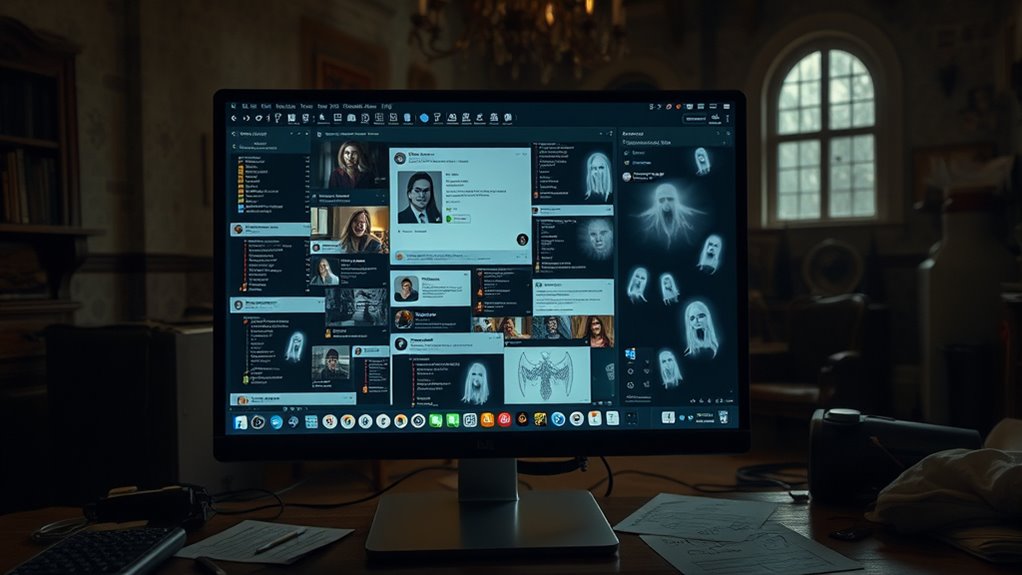
While digital crowd investigations offer a vast pool of data and diverse perspectives, they also face significant challenges that can hinder their effectiveness. One major issue is the quality and accuracy of user-submitted data, which can vary widely. Without proper verification, false or misleading information may contaminate the investigation. Additionally, the lack of expert oversight can lead to misinterpretations or overlooked details. Coordination among a large, decentralized crowd can also be difficult, causing inconsistencies and duplicated efforts. Technical limitations, such as insufficient tools for analyzing vast data sets, further restrict progress. Finally, participants’ biases and subjective interpretations can influence findings, making it harder to reach reliable conclusions. These challenges emphasize the need for careful management and validation in digital crowd investigations. Understanding the importance of ethical hacking can help ensure responsible data handling and security in online investigations.
Ensuring Credibility and Validity in Public Contributions
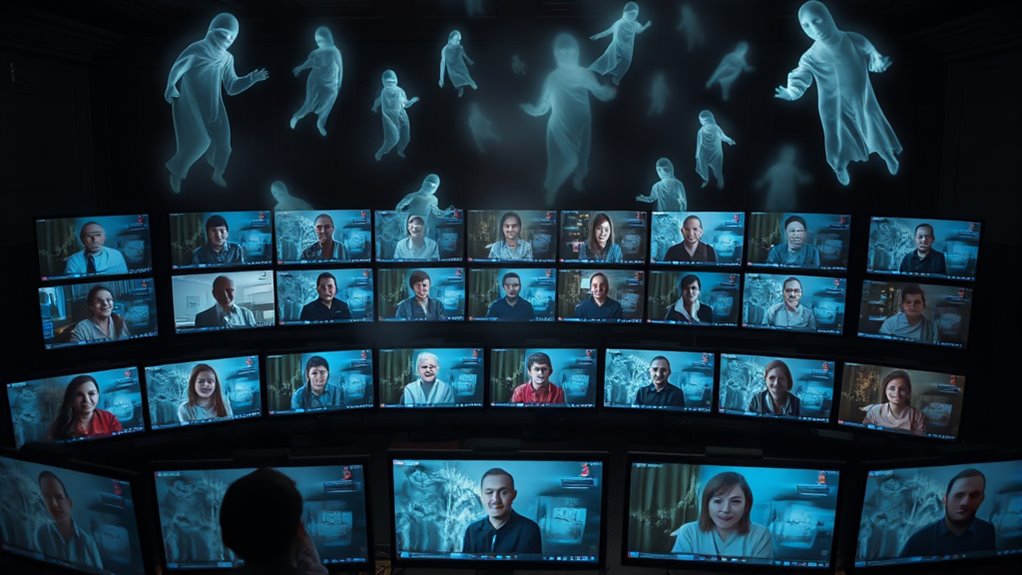
To guarantee public contributions are credible, you need to verify evidence carefully and consistently. Standardizing how data is collected helps minimize errors and biases. By focusing on these points, you can strengthen the validity of crowdsourced paranormal investigations. Implementing filter replacement indicators and monitoring air quality indicators can serve as useful models for establishing clear and measurable criteria in data collection processes.
Verifying Evidence Rigorously
Ensuring the credibility and validity of evidence collected through public contributions requires a rigorous verification process. You should start by cross-checking submissions against multiple sources, such as other pieces of evidence or witness accounts. Use technical tools like audio or video analysis software to identify inconsistencies or signs of tampering. Encourage contributors to provide detailed descriptions and context, which helps evaluate the authenticity of their evidence. Implement peer review or expert panels to assess submissions objectively. Establish clear criteria for what qualifies as credible evidence and document your verification steps transparently. By maintaining strict standards and thorough validation, you guarantee that only reliable, well-substantiated evidence advances your investigation. This approach builds trust and enhances the overall quality of your crowdsourced findings.
Standardizing Data Collection
Building on the importance of verifying evidence, establishing standardized procedures for data collection helps maintain consistency and credibility across public contributions. When you follow clear guidelines, it becomes easier to compare findings and identify genuine anomalies. Use specific protocols for recording data, such as consistent camera settings, timestamping, and detailed note-taking. Train contributors on how to avoid common pitfalls, like misidentifying environmental sounds or misinterpreting visual artifacts. Implement checklists to ensure all relevant details are captured uniformly. By standardizing your approach, you reduce subjective bias and improve overall reliability. This consistency fosters trust among participants and skeptics alike, creating a more credible dataset. Ultimately, standardized data collection strengthens your investigation’s validity and helps build a more compelling case for paranormal phenomena.
Tools and Technologies Empowering Citizen Scientists
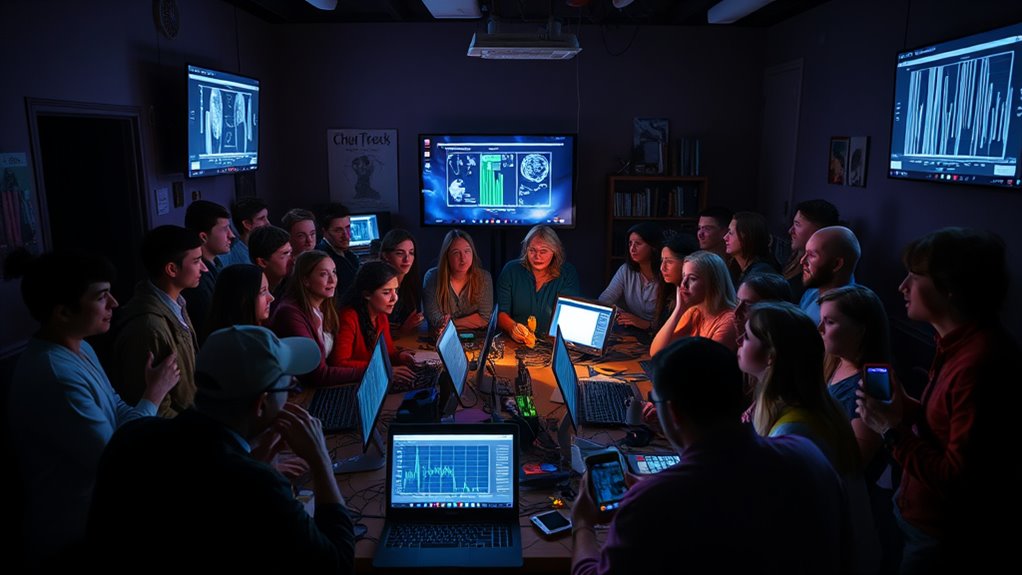
Advancements in technology have considerably expanded the toolkit available to citizen scientists investigating the paranormal. Today, you can leverage affordable sensors, smartphone apps, and online platforms to gather and analyze data more effectively. These tools enable real-time measurement of electromagnetic fields, temperature fluctuations, and audio-visual recordings, helping you document unusual phenomena with greater accuracy.
| Tool Type | Functionality |
|---|---|
| EMF Meters | Detect electromagnetic anomalies that may indicate activity |
| Smartphone Apps | Record audio, videos, and log environmental data |
| Cloud Platforms | Store, share, and analyze investigation data collaboratively |
These innovations empower you to contribute meaningful insights and foster a more scientific approach to paranormal investigations.
Building a Collaborative Community of Investigators
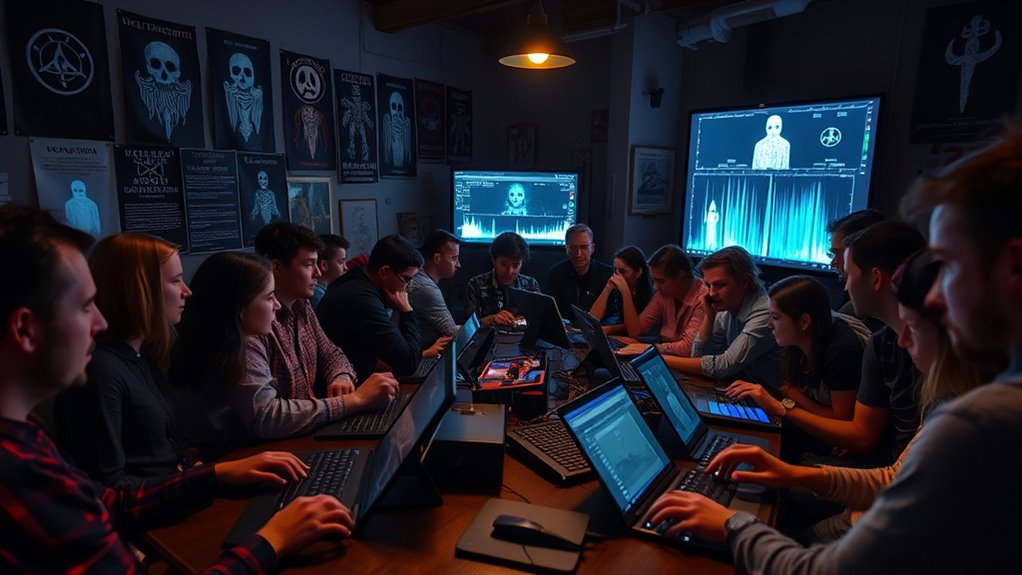
The increasing availability of advanced tools and technology makes it easier than ever for citizen scientists to connect and collaborate. You can join online forums, social media groups, and dedicated platforms to share findings, ask questions, and coordinate investigations. Building a community relies on open communication, so you’ll want to foster an environment where members feel comfortable sharing ideas and concerns. Establish clear goals and guidelines to keep everyone aligned and motivated. Regular virtual meetings or live discussions help build trust and camaraderie among members. By pooling your collective knowledge and resources, you enhance the quality of investigations and create a supportive network. This collaborative approach not only increases the credibility of your work but also makes the experience more engaging and rewarding for everyone involved.
Future Trends in Digital Paranormal Exploration
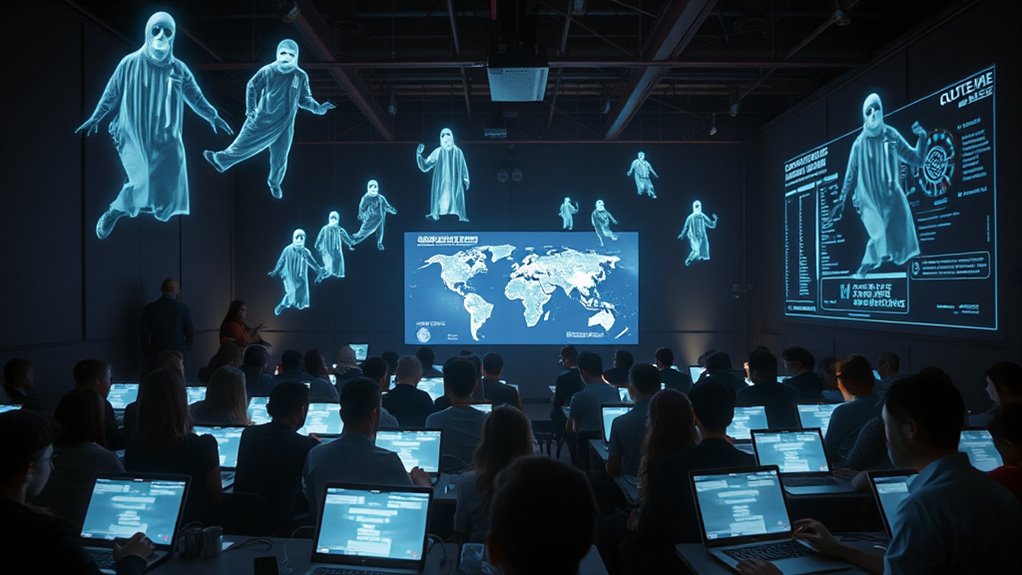
As technology continues to evolve, digital tools are transforming how paranormal investigations are conducted, offering new ways to gather and analyze evidence. Expect advanced AI algorithms to identify patterns in data, making evidence more reliable. Virtual and augmented reality will enable immersive investigations, allowing you to explore sites remotely. Enhanced mobile apps will facilitate real-time crowd collaboration, increasing data accuracy. Drones equipped with sensors might access hard-to-reach areas, expanding investigation possibilities.
| Technology | Application | Impact |
|---|---|---|
| AI & Data Analysis | Pattern recognition, evidence sorting | Faster, more accurate findings |
| VR & AR | Remote site exploration | Broader participation |
| Drones | Access to remote or dangerous areas | Safer, all-encompassing data collection |
Frequently Asked Questions
How Do Online Platforms Verify the Accuracy of Crowd-Contributed Paranormal Evidence?
Online platforms verify crowd-contributed paranormal evidence by using multiple methods. You should look for corroboration from different users, analyze timestamps and geolocation data for consistency, and check if the evidence has been reviewed by experts or moderators. Platforms may also employ software tools to detect false or manipulated media. By combining community validation, expert input, and technical analysis, you can increase confidence in the authenticity of the evidence.
What Legal or Ethical Concerns Arise From Remote Paranormal Investigations?
You should consider privacy issues, as remote investigations might uncover sensitive personal information without consent. There’s also the risk of spreading false or misleading evidence, which can damage reputations or cause unnecessary panic. Ethically, you need to respect individuals’ rights and avoid exploiting fears for entertainment or profit. Ensuring transparency, obtaining consent, and verifying evidence help address these legal and ethical concerns responsibly.
How Can Beginners Effectively Participate in Crowdsourced Paranormal Projects?
You should start by researching reputable projects with clear guidelines. Over 60% of beginners find success by actively sharing their experiences and observations online. Be respectful of others’ privacy, follow site rules, and document your findings accurately. Engage with community forums to learn tips from experienced members. Remember, patience and curiosity drive meaningful contributions—your keen eyes and open mind can help uncover exciting paranormal insights.
Are There Privacy Risks Associated With Sharing Paranormal Investigation Data Online?
Yes, sharing paranormal investigation data online can pose privacy risks. You might unintentionally reveal personal details about yourself or others involved, or expose sensitive locations. To protect yourself, anonymize data, avoid sharing specific addresses, and be cautious about revealing personal information. Always review platform privacy policies and settings, and consider what details you’re comfortable making public, ensuring you balance sharing findings with safeguarding your privacy.
What Funding Sources Support the Development of Digital Crowdsourcing Tools for Paranormal Research?
Funding sources for developing digital crowdsourcing tools often act like hidden treasures, fueling your paranormal research adventures. You can tap into grants from scientific organizations, crowdfunding campaigns, or university partnerships that support innovative projects. Tech companies and nonprofit foundations also see value in these tools and may offer sponsorships. By exploring these avenues, you’ll find the resources needed to build user-friendly platforms that empower enthusiasts to uncover the unknown together.
Conclusion
Just like the spirited explorers of the past who charted unknown territories, you now have the power to uncover mysteries from your own home. Crowdsourcing paranormal investigations harnesses collective curiosity and technology, turning everyday enthusiasts into citizen scientists. As you contribute and collaborate, remember that, like the legendary quest for the Holy Grail, the journey may be unpredictable, but it’s driven by shared passion and discovery. Keep exploring—who knows what secrets you’ll reveal next?
